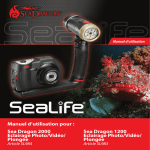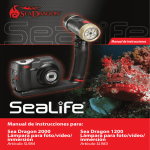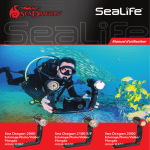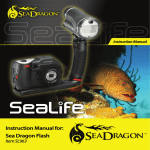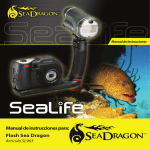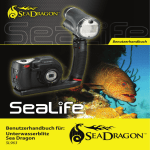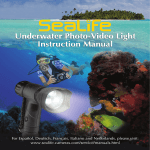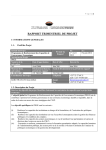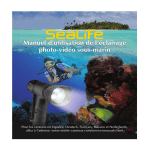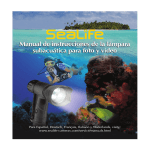Download Sealife Sea Dragon 1200 Light Troubleshooting guide
Transcript
Contents: I. Safety Warnings........................................................3-4 II. Check What You Got ...................................................5 III. Product view with call-outs .........................................6 IV. Charging and Loading the Battery ...............................7 V. Operating the light ......................................................8 VI. Battery Status Indicator................................................8 VI. Maintaining a waterproof seal (Before your dive) ........9 VII. Care and maintenance (After your dive) ....................10 VIII. Replacing the O-rings................................................11 IX. Attaching light to underwater camera........................12 X. Expanding your Flex-Connect™ Lighting System ....13-14 XI. Recommended Camera Settings ................................15 XII. Great pictures made easy .....................................16-19 XIII. Advanced Settings .....................................................20 XV. Troubleshooting Guide ..............................................21 XVI. Specifications ...........................................................22 XVII. Parts and Service .......................................................23 www.sealife-cameras.com/service/manuals.html Español - Deutsch - Français - Italiano - Nederlands 2 I. Safety Warnings Make sure you follow these important safety warnings to avoid the risk of fire or injury. Avoid using the light above water for prolonged periods of time. The light is designed for underwater use and water is needed to displace heat. The metal light head at full power will reach temperature of about 140F (60C) degrees within a few minutes, which may cause burning if touched. A thermal sensor will automatically dim the light if internal temperatures reaches 150F (65C) degrees. Immediately turn off light if any parts of the light become hot to the touch. If water has entered the light, immediately turn off power and follow these instructions: Remove and dry the battery. DO NOT use the battery once it has become wet. Wet batteries must be replaced. Allow battery to dry and dispose it in accordance with local battery recycling regulations. The battery chamber is waterproof. If no water has entered the LED light head, the chamber may be cleaned without causing permanent damage to the electronics. Rinse the waterproof battery compartment with fresh water and allow the inside to dry. Replace the o-rings and apply lube. Install new, fully-charged battery and test light. If light does not operate properly, please contact your local SeaLife dealer or the SeaLife service center in your country. Do not use battery if the outer casing is cracked, separated, damaged or has become wet. Dispose battery in accordance with local battery recycling regulations. 3 I. Safety Warnings Never expose battery to fire or intense heat. Do not expose light to direct sunlight for prolonged periods of time. Airlines impose strict safety regulations for handling and shipping lithium ion batteries. Spare lithium batteries may not be packed in your checked baggage but may be packed in your carry-on baggage. It is important to pack spare batteries in such a way as to prevent metal objects from touching the contacts and potentially short-circuiting the battery. Always use protective battery cover included when the battery is not inside the light or charging tray to prevent accidental shortcircuiting the battery contacts. Remove batteries from light before transporting, traveling or long periods of storage. Remember to use the protective battery cover included when the battery is not inside the light or charging tray to prevent accidental short-circuiting the battery contacts. Only use the specified battery and battery charger approved by SeaLife. Using any other battery or charger may cause fire, injury and permanently damage the light. Observe all SCUBA dive safety rules and control your buoyancy at all times. Consult your dive instructor for dive safety questions. Visit www.sealife-cameras.com for updates to this manual and underwater photography tips. 4 II. Check What You Got Sea Dragon 2000 Light (with grip and standard tray) -ORSea Dragon 1200 Light (with grip and micro tray) Li-ion Battery (SL9831) w/protective cover O-ring Lube (SL9807) Charging tray (SL98311) Sea Dragon Case (Small SL941 or Large SL942) O-ring remover (SL9808) AC Power Adapter (SL98312) Spare O-rings Int'l Plug Inserts (SL98306) (SL98303) Adapter for GoPro camera (SL9813) 5 III. Product view with call-outs Major parts 1 – Light head 2 – Metal cooling bezel 3 – Release buttons 4 – Flex-Connect grip 5 – Tray 6 – Mounting screw 7 – Rubber friction pad 8 – Power button / Brightness adjust 9 – Battery status indicator 10 – Battery cap 11 – Pressure safety valve 12 – Flex-Connect swivel connector 6 IV. Charging and Loading the Battery 1) Charge battery (green light = fully charged) 2) Unscrew the battery cap 3) Insert fully charged battery. Important: Make sure O-ring and sealing surfaces are perfectly clean and undamaged. 4) Screw on battery cap. (Do not overtighten or use tools.) 7 V. Operating the light 1) Push and hold the power button for 1 second to power ON the light. 2) Push the power button to change between the following light modes: 100% § 50% § 25% § 100%........ 3) Push and hold the mode button for 2 seconds to power OFF the light. VI. Battery Status Indicator 3 status lights indicate remaining battery power: Status lights 3 solid 2 solid 1 solid 1 blinking 8 Battery power 100% 75% 50% 25% VII. Maintaining a waterproof seal (Before your dive) 1) The light uses two O-rings to maintain a waterproof seal. 2) Every time you open the battery cap make sure the O-rings and sealing surfaces are clean, undamaged and lubricated. 3) Dampen a clean cotton cloth and wipe it around the o-ring and o-ring contact surfaces to remove any hair, sand or debris. 4) Carefully inspect the o-ring for cuts, tears or other damage. Replace o-rings if damaged. 5) Lube O-rings regularly. Apply a small amount of silicone lube on your finger tip and wipe it around the O-rings. Wipe off excess lubricant. The o-ring surface should have shiny, wet appearance. Important: Replace O-rings every year if damaged or not. Visit your local SeaLife dealer or www.sealife-cameras.com for information on ordering spare o-rings. 9 VIII. Care and maintenance (After your dive) 1) After each dive, soak the sealed light in fresh water for about 15 minutes to remove any residual salt, sand and dirt. Never allow the saltwater to dry on the light. 2) Push the power button about 10 times to clean any saltwater or sand trapped under the button. 3) Let the water drain out of the small holes located at the bottom of flex arm. (If using Flex Arms - see page 13 for optional accessories). 4) Dry off the light with a towel. Make sure you and the light are dry before opening the waterproof battery cap. 5) Remove battery before storing the light. 6) Allow light to thoroughly dry before storage. 7) Never use any detergents, cleaners, solvents or chemicals to clean the light. 8) Insert a fresh Moisture-Muncher capsule (item #SL911) inside the battery compartment during storage to help keep the inside dry and free of corrosion or mildew during storage. 10 IX. Replacing the O-rings Replace the two O-rings if damaged or at least once per year. 1) Use the O-ring Remover tool provided to lift and remove the O-rings. 2) Carefully clean O-ring grooves and O-rings before installation 3) Install O-rings by stretching and lifting O-ring into the groove. Do not roll the O-ring or allow it to twist. 4) Apply a small amount of silicone lube on your finger tip and wipe it around the O-rings. Wipe off excess lubricant. The o-ring surface should have shiny, wet appearance. 11 X. Attaching light to underwater camera Important: Only attach the light to cameras/housings with minimum thread depth of 0.28" and using standard 1/4-20 tripod type thread. Don’t over-tighten screw or you may damage the housing and threads. Align the underwater camera to the light’s mounting screw and hand-tighten. 12 XI. Expanding your Flex-Connect™ Lighting System Get brighter, more colorful results by expanding your Sea Dragon underwater camera system. The modular Flex-Connect arms, grips and trays easily clicks together to create these popular configurations: Pro Set Pro Duo Maxx Duo w/ single flash w/ light, flash and dual tray w/ light, flash, 2 flex arms and dual tray Flex Arm - “Click” on the Flex Arm for more creative lighting and easy aiming. Reduces backscatter by positioning the flash or light farther away from the camera. Add up to two arms per side. Each arm features 100° bending motion and adds 7” length in addition to the 5” grip (SL9901) Grip – Rubberized grip for a comfortable hold. Built-in channel to hide and secure optical cable. (SL9905) 13 Expanding your Flex-Connect™ Lighting System (continued) Select from three universal mounting trays: Dual Tray - Add another flash or light with the dual tray to double brightness, reduce shadowing and stabilized aiming control. Sold separately (SL9904) Micro Tray – This tiny tray is the perfect fit for compact cameras. Included with Sea Dragon 1200 Light or sold separately (SL9902) Single Tray – The standard single tray is ideal for medium size underwater cameras. Included with Sea Dragon 2000 Light and Digital Flash or sold separately (SL9903). Cold Shoe – Mount a light or flash over the camera for the most compact lighting solution available. Or use it to add a third light when using a dual tray. Easily slides on to cold shoe of SeaLife and most other underwater housings. (SL991). 14 XII. Recommended Camera Settings For SeaLife camera with external light accessory (No external flash): 1) Set the camera’s scene mode to Sea mode or Snorkel mode 2) Change camera’s PHOTO and VIDEO White Balance settings to DAYLIGHT. For SeaLife camera with external light and flash accessories: 1) Set the scene mode to Ext. Flash mode 2) Change the VIDEO White Balance setting to DAYLIGHT. Note: The white balance settings for Photo and Video modes function independently of each other. For other underwater camera brands: 1) Set the Scene mode to “Auto” or “Underwater” scene mode, as recommended by the camera manufacturer. 2) You may also need to change the White Balance setting to DAYLIGHT depending on the camera’s underwater color correction or if pictures/video turns out red. 15 XIII. Great pictures made easy There are plenty of challenges that photographers face in the underwater world. Please take some time to review SeaLife’s online guide called Great Pictures Made Easy by visiting www.sealife-cameras.com. The guide is located under the Technical Support menu. The following information summarizes the basic principles of underwater photography. Crystal clear water Clear water is essential for good underwater pictures. Low visibility, caused by fine particles suspended in the water, will diminish the picture and video quality. As a general rule, limit your shooting distance to 1/10 of the water visibility. For example, if the visibility is 20 ft, limit your shooting distance to 2 ft. Try to keep the light as far away from the camera lens as possible to minimize backscatter. 16 Limit your shooting distance Water is 800 times denser than air and quickly absorbs light. The Sea Dragon 1200 and 2000 lights have an effective range of about 3ft (90cm) to 4ft(120cm) depending on visibility and ambient light conditions. The SeaLife external flash accessory has an effective range of 6ft (1.8m) to 8ft (2.4m). If you are using the SeaLife underwater light in combination with the SeaLife flash, limit your shooting distance to 6 ft (1.8m). 4 ft (1.2m) is ideal. If you are using the SeaLife light only, limit your shooting distance to 2 ft (60cm) to 3ft . Closer shooting distances result in better pictures and video. Consider purchasing the SeaLife Wide Angle Lens accessory, which allows you to keep a closer shooting distance and fit everything into the picture. 17 Control your buoyancy Get your buoyancy under control and set yourself up in the ideal position before taking a picture or shooting video. This allows you to hold the camera steady and control your shooting distance. Good buoyancy control will help you avoid stirring up the sandy bottom which will cloud-up the water and cause backscatter. Controlling your buoyancy is very important for your diving safety so don’t start shooting until your buoyancy is under control. Practice makes perfect There is no better way to learn than from your mistakes. Become familiar with your camera controls so you can make quick adjustments depending on the conditions. Take the time to practice and experiment with different settings. Review your pictures and learn from your mistakes. 18 Compose a good picture Avoid shooting down on the subject from above. Shooting down usually results in a poor contrast because the subject blends into the background. Try and shoot upwards from below the subject so you get a blue water background and better contrast. Get the entire subject into your picture frame. Don’t cutoff the hands, fins or head of your subject. You can always crop you image later on your computer if you want. Video tips Hold the camera as steady as possible and move (pan) very slowly. A jumpy, fast-moving video is hard for anyone to watch and can actually cause motion sickness Avoid shooting video clips more than 1 minute. It is difficult to edit a lengthy video clips because the large file size. You can always patch together short video scene into a longer movie using video editing software, like Microsoft Movie Maker. Always observe dive safety rules and Never Touch Marine Life Do not let photography distract you from diving safely. Observe marine life - Never touch marine life. Be aware of your surroundings to avoid contacting anything. Keep your dive gear close to your body. 19 XIV. Advanced Settings Auto Flash Detect The light includes a flash sensor that will turn off the light for 2 seconds if it detects an external flash firing. This feature helps reduce backscatter. You may disable the auto flash detect as follows: 1) With light in the OFF state, push and hold the power button for 3 seconds. 2) Release the power button when the indicator lights begin blinking and light turns off. 3) Two quick blinks per second indicates Flash Detect is enabled. One blink per second means the Flash Detect is disabled. 4) Push and release power button to switch modes. 5) Push and hold the power button to save and exit the Flash Detect setting. Performance and Economy modes The light is set to "Performance" mode, which means it maintains constant brightness (lumens) even as the battery charge is depleted. The light can also be set to "Economy" mode, so the brightness gradually reduces as the battery charge drops, which doubles the battery life (burn time). To select between these two modes: 1) With light in the OFF state, push and hold the power button for 7 seconds. 2) Release the power button when the middle indicator light begins blinking. 3) Two quick blinks per second means the light is set to Performance mode. One blink per second means the light is set to Economy mode. 4) Push and release power button to switch between the two modes. 5) Push and hold the power button to save and exit the mode setting. 20 XV. Troubleshooting Guide Light does not power ON Make sure battery is fully charged and contacts are clean. Replace battery if it has become wet or is damaged.. Blue or dark pictures/videos Keep your shooting distance inside of 2ft to 3ft, depending on visibility and ambient light. If you are using only one light, considering adding another light (dual lights) or/and external flash accessory. The ideal set-up is a combination of a light plus flash. Consider purchasing the SeaLife Wide Angle Lens (SL975). The fisheye lens allows you to get closer to the subject and fit more into to picture frame. Pictures or Videos too red The camera’s white balance setting is not set correctly. Refer to page 15 of this manual for information on camera settings. For updated information and advice, please refer to the SeaLife website at www.sealife-cameras.com or contact your local SeaLife dealer or service center for help. 21 XVI. Specifications Sea Dragon 1200 (item SL983) Light source/ Bulb type: Brightness: Effective Range: Run [Burn] time: 6 x 3W LED Light (CREE XPG LEDs) 1200 lumens 3 ft / 1m (depend on camera model, water visibility and battery condition) 75 minutes at full power/150 min at half power/300 min at quarter power Sea Dragon 2000 (item SL984) Light source/ Bulb type: 6 x 3W LED Light (CREE XPL LEDs) Brightness: 2000 lumens Effective Range: 4 ft / 1.2m (depend on camera model, water visibility and battery condition) Run [Burn] time: 60 minutes at full power/120 min at half power/240 min at quarter power Shared specifications Body material: Brightness control: Color temperature: Beam angle: Battery: Depth: Light modes: Dimensions: Weight: Bulb life: O-ring: Buoyancy: 22 Anodized aluminum light head with fiber-reinforced polycarbonate body 100%, 50% and 25% power 5300 ~ 5700K 100 degrees Lithium Ion 7.4V, 3100 mAh, 23 Wh (included) Tested to 200 ft (60m) Full power (100%), half power (50%) Quarter Power (25%) 8.5” x 9.5” x 2.3” (22cmx24cmx6cm) fully assembled light head w/battery, grip and tray 23 ounces (652 grams) light head w/battery, grip and tray 35,000 hours Dual NBR o-rings (lube included) Negative XVII. Parts and Service SeaLife guarantees the original purchaser of this product, for a period of one (1) year from the date of purchase, that the product is free from defects in workmanship and materials. For a detailed warranty statement, please refer to the warranty information included with the product. In the event the original purchaser believes there is a defect in a product, it is recommended that the purchaser first visit www.sealife-cameras.com for product updates and technical advice. The SeaLife website also includes detailed information on how to get repair service. Happy Diving! SeaLife www.sealife-cameras.com 23
























